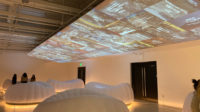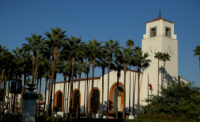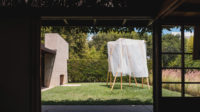A visit to the Japan House gallery in Los Angeles requires navigating a flashy, raucous, multi-story tourist mall called Hollywood & Highland—the local version of Times Square—to reach a glassy, second-floor storefront. But just over the threshold is another world, where delicate, Zen-like design objects occupy a serene, white minimalist retail shop, leading into a spacious gallery at the rear. The contrast with the mall’s Vegas-like glitz and bustle is extreme, but also perversely well suited to the gallery’s current show: Sou Fujimoto: Futures of the Future (on view through December 12, 2018).
After all, the Japanese architect Fujimoto is known for his own unexpected juxtapositions. He began his career investigating the architecture of ordinary household objects: a kitchen-sink drain screen, a textured scrub sponge, bars of staples, matchboxes, crumpled paper or cellophane, and others. Within these “environments,” he placed tiny, white scale figures, altering our perception. Suddenly, a few carefully composed potato chips turned into deep-walled canyons; or a small, overturned, expandable-mesh plastic sack (packaging designed for a single fragile piece of fruit) became a soaring, almost religious, space for a minuscule human figure.
Visitors to the show can peruse such delicate models at remarkably close range, beginning just outside the gallery, where the exhibition spills into the retail space—introducing the work’s recurrent theme of inside-out ambiguity. Here, simple pedestals, stemmed in black pipe and topped with plywood disks, hold a single model each—many small enough to fit in the palm of a hand. With no protective display cases, the immediacy is striking, inviting viewers to approach familiar objects and then—as they spot the tiny figures—experience a whimsical, yet thought-provoking, shift in scale, altering the entire reading.
The title “Futures of Future” reflects Fujimoto’s belief that many visions for the future will be possible, including yet-unrealized investigations that he began years ago. The architect designed the installation himself, adapting it for Japan House locations (all cultural-retail venues) in Sao Paulo, then London, and now, for the show’s final stop, in Los Angeles. Here, the forest of more than 100 of the waist-high pedestals continues into the gallery, where diminutive models meet very large ones. Among the biggest is an unbuilt study for a park in Belgrade, proposing a freeway-like vortex of raised walkways. Playing against the 3D objects, large photos line the surrounding walls, presenting such buildable or built projects as L’Arbre Blanc apartments for Montpelier, France, a tower with generous outdoor terraces jutting out like bristling porcupine quills.
The exhibition’s seemingly loose organization invites “a network of pathways,” says Fujimoto, encouraging visitors to make their own routes and mental leaps. The work’s multiple underlying themes range from complex and dynamic circulation proposals (as in structures with myriad Escher-like stairways) to investigations into prismatic transparency to built forms sprouting with trees. “This show is like an explosion of my brain, of my thinking,” says the architect, “but it’s not just about me—it’s also about actual sites and how the real world affects those ideas.”
Though his early practice became most widely known for its small, experimental houses in Japan; and the 2013 Serpentine Gallery Pavilion in London, his offices in Tokyo and Paris now have more than 50 projects, many of them large scale, currently in progress. (They include, for example, Budapest’s House of Music, a museum-and-performance venue with an expressively perforated, wafer-like roof floating above a forested park.)
The profusion of ideas remains striking. As Fujimoto commented in a booklet available at the show: “My work has expanded in ways that I never could have imagined. When I am invited to do a project, I feel as if I am being summoned to discover something.” And in “Futures of Future,” that sense of perpetual exploration—shared with the viewer—definitely comes through.










